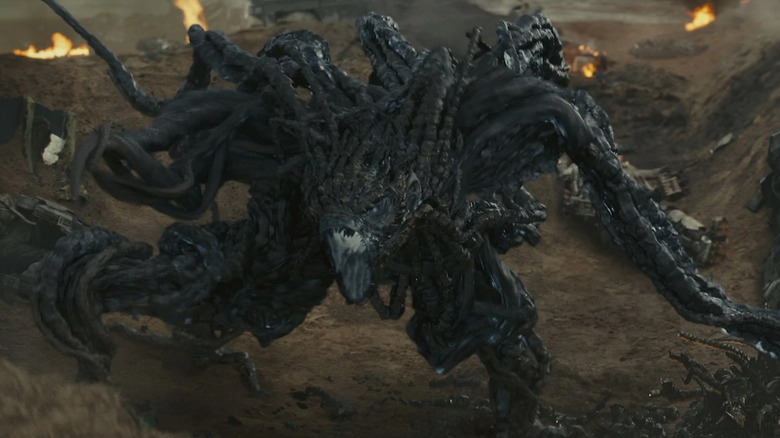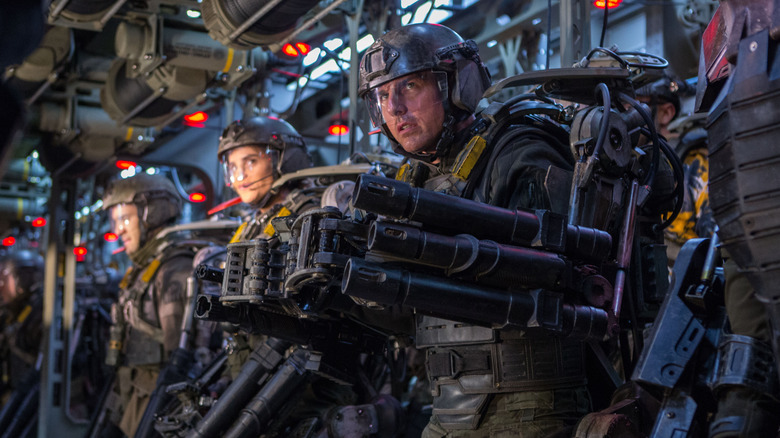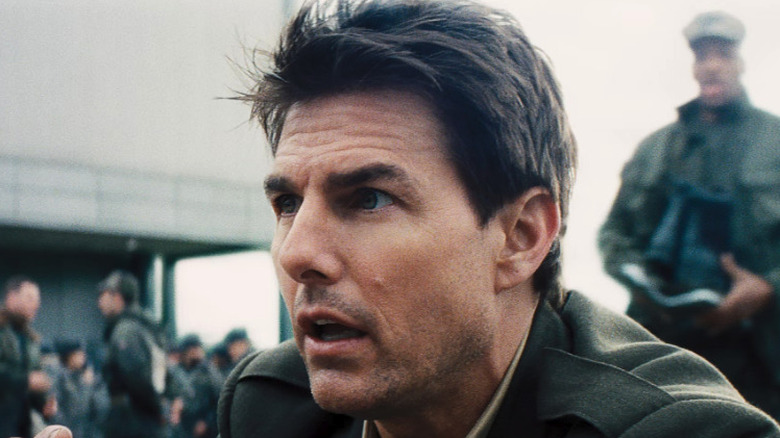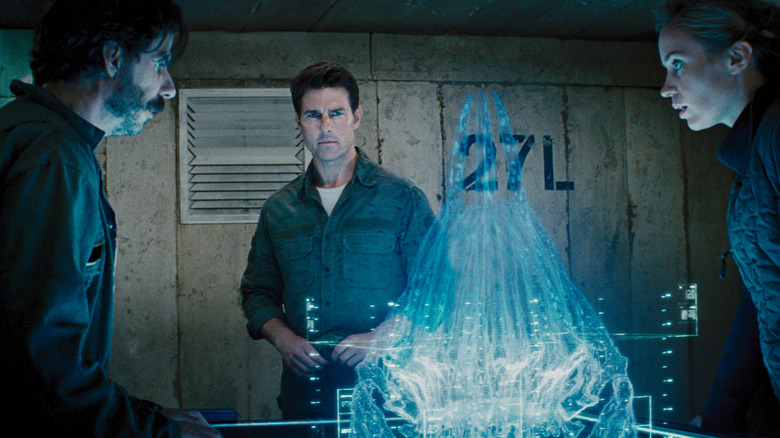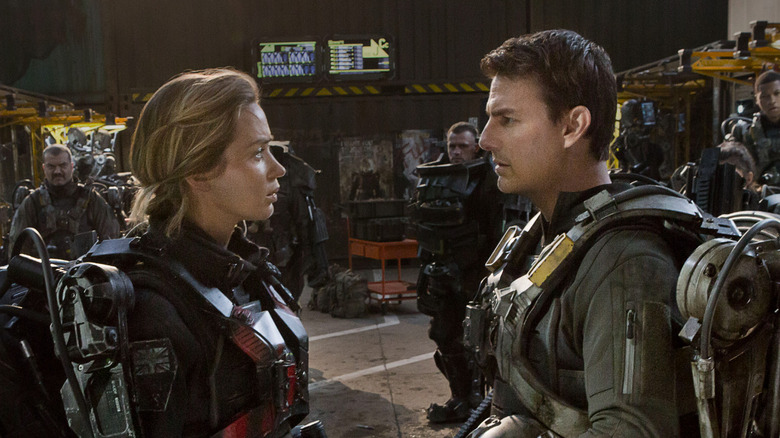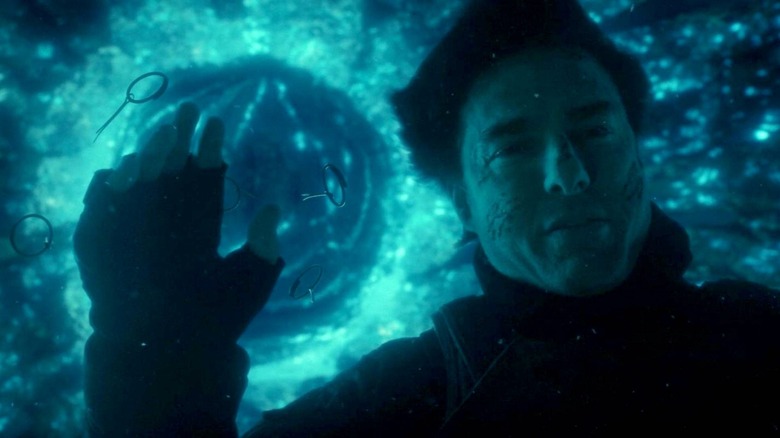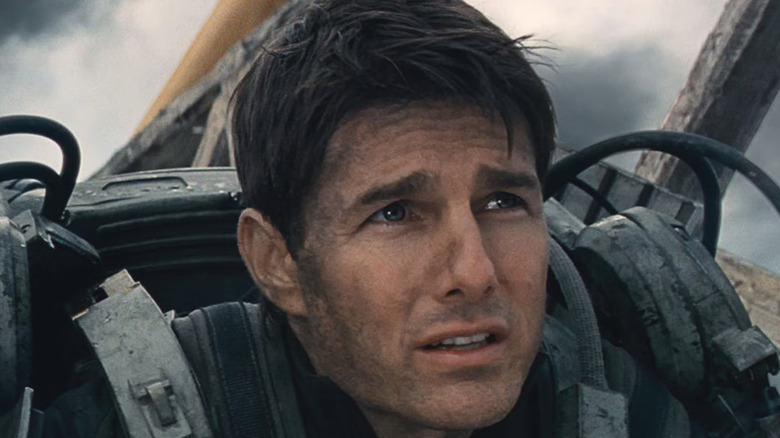Edge Of Tomorrow's Most Confusing Moments Explained
Though considered a box office disappointment upon its release in 2014, "Edge of Tomorrow" (a.k.a. "Live Die Repeat") remains one of the decade's most underrated sci-fi movies. Directed by Doug Liman and starring Tom Cruise and Emily Blunt, "Edge of Tomorrow" is a futuristic action-adventure twist on "Groundhog Day," following a reluctant soldier who lives out the climactic battle against alien invaders over, and over, and over again.
The past ten years have seen an explosion of new movies and TV shows about characters trapped in time loops, from "Happy Death Day" to "Russian Doll," but "Edge of Tomorrow" is particularly fun for the way the development of Tom Cruise's Major William Cage parallels the way players develop skills and experience in a video game. Many viewers can relate to the character's experience of grinding through a seemingly impossible task again and again, using the advantage of unlimited tries to build confidence in your skills and a better understanding of the challenge ahead. "Edge of Tomorrow" pairs this familiar feeling with a funny and engaging story of a character who, through a bizarre twist of fate, must keep playing this impossible stage forever.
It's possible to get overwhelmed by the mechanics and minutiae of the movie's science fiction plot — here's hoping we can clear up all of your concerns without repeating ourselves.
Is the movie called Edge of Tomorrow or Live Die Repeat?
The film — whatever you call it — is based on a novel by Hiroshi Sakurazaka entitled "All You Need Is Kill." According to an interview with Variety, Warner Bros. President of Marketing Sue Kroll found that audiences were put off by movies with the word "Kill" in the title, leading to the project's rebranding. Director Doug Liman, on the other hand, later told Den of Geek that the film was renamed to accommodate the film's tone, which is significantly lighter than that of the source material. He suggested that the film be renamed "Live Die Repeat" instead. Someone at Warner Bros. wasn't fond of this title, and bequeathed the project the more generic-sounding title "Edge of Tomorrow," against Liman's objections. "Live. Die. Repeat." was used as a tagline for the movie instead. Liman feels that this contributed to the film underperforming at the box office despite critical acclaim.
Someone must have listened, because when the movie was released on home video months later, "Live. Die. Repeat." was suddenly the larger print on the box, and digital marketplaces listed the full title as "Live Die Repeat: Edge of Tomorrow." Depending on when you purchased a physical copy of the movie, it may feature the two titles in a different order. Doug Liman told Den of Geek that the sequel's working title is "Live Die Repeat Repeat," and that its release would canonize "Live Die Repeat" as the title of the first film.
Has the UDF really turned the tide of the war?
In the film's opening montage, we learn that a meteor has crashed to Earth, bringing with it an invasive extraterrestrial species that humans call "Mimics." They've been spreading across Europe for years, easily overcoming all conventional military defenses. To combat this alien menace, the world's governments join together to form the United Defense Force, or UDF, and begin manufacturing suits of powered armor for their infantry.
When the UDF has their first victory at the Battle of Verdun, the belief is that the new mech suits have proven their worth. After all, Sgt. Rita Vrataski was able to use one to perform incredible and daring feats despite limited experience, proving that (as Major Cage will repeat to the media dozens of times) anyone with minimal training can operate one efficiently. In actuality, Rita's apparently instant mastery of the armor and the battlefield were the result of her ability to repeat any day in which she dies, giving her unlimited replays of any deadly scenario. Since the UDF is unaware of this (and refused to believe it in any of Rita's previous lives), they move forward confidently with an aggressive invasion of France, Operation: Downfall.
However, Rita and her ally Dr. Carter suspect there's still another layer to the Battle of Verdun. They believe that the Mimics eventually allowed the UDF to win at Verdun in order to lend them a false sense of confidence, prompting an all-out assault that would allow the Mimics to annihilate the UDF in a single stroke. It's also possible that the Mimics accepted the result of the Battle of Verdun that ended with Rita losing her ability to reset, deciding that this was victory enough.
Why are the aliens called Mimics?
Throughout the story of "Edge of Tomorrow," the shape-shifting alien menace that's conquering Earth is always referred to as the "Mimics." It's a cool-sounding name that helps to uniquify the film's villain, avoiding the constant reuse of the words "alien" or "enemy." However, although the Mimics do look and move in a strange, ever-changing way, it's never exactly clear who or it is they're "mimicking."
To find an answer to this question, you'd have to go back to the source material, the light novel "All You Need is Kill" by Hiroshi Sakurazaka. There, it's explained that the aliens based their earthly shape on the first life form they encountered after crash-landing on our planet: a starfish.
This idea isn't really represented in the film, with the Mimics receiving a totally original design that doesn't map easily onto anything in our animal kingdom. Their forms are constantly changing, their metallic tentacles forming into legs or sharp spikes, or unraveling so that they can rest flat in the dirt beneath their prey. Since the Mimics' bodies are incredibly fast and perpetually reshaping themselves, the audience rarely gets a good, long, look at them. Ironically, this makes them one of the more interesting and memorable alien designs in recent memory, since we get an idea as to what they look like, but would struggle to describe them to another person. "Starfish" doesn't really cut it, and neither does any other comparison. "Mimic" will have to do.
How many times does Cage die?
When cowardly publicity officer Maj. Cage attempts to blackmail his way out of combat duty, he's demoted to Private and forced onto the front lines of the UDF's invasion of France. After seeing the rest of his squad slaughtered, Cage grabs a claymore mine and blows apart both himself and a particularly imposing Mimic, intermingling their blood as he dies. He awakens the previous day, having acquired the ability to essentially respawn from the same save point every time he's killed, retaining all his memories and skills from all of his previous attempts. Once he realizes that there's no way to convince his superiors of what's happened to him, Cage uses his foreknowledge of the events of the day to experiment with different ways to potentially win the battle.
Though we follow Cage all the way through his first two lives so that we can observe him coping with his new reality, the film quickly falls into a stride in which the audience only sees the most relevant or successful cycles in Cage's time loop. Nearly every time we see him from this point on, it's evident that his latest life is informed by dozens, if not hundreds of unseen repetitions of whatever he's currently attempting. This means that, even though we see him die a mere 26 times in the film, the real number is probably upwards of 1000.
How does Rita know that she can't reset time anymore?
When Cage rescues Sgt. Rita Vrataski on the battlefield, demonstrating a clear foreknowledge of the dangers around them, Rita realizes that he must be on a time loop and instructs him to "find [her] when [he] wakes up." In his next life, Cage finds Rita and learns that, months earlier, she also absorbed the blood of an Alpha Mimic, gaining the ability to start the day over upon her death. However, she lost that ability on her last loop, during which she managed to win the Battle of Verdun but also suffered serious, non-lethal blood loss. When she received a transfusion of new, normal blood, she lost the ability to reset the day.
Upon hearing this, we can't help but ask one logical question: How can Rita possibly know that she no longer resets time when she dies, unless she died and didn't come back? This, unfortunately, is something the viewer simply has to accept in order for the movie to work. To patch up this potential plot hole, we're forced to accept that Rita (and later, Cage), can simply feel that their ability to reset time is gone. We see it happen to Cage, after he suffers his own similar injury and blood transfusion in the final loop of the film.
Is it beyond belief that Mimic Alphas would have such a sixth sense that allows them to know whether or not they're detached from the time stream? Not entirely. One can imagine that such an instinct might have evolved within Mimics in order to alert an Alpha that it's lost its metaphysical save state. Still, it's certainly convenient for our heroes — and for the audience.
How does the time reset work?
Dr. Carter does a pretty solid job explaining the mechanics of "Edge of Tomorrow's" time travel during his initial meeting with Cage. While most Mimics are of the animalistic soldier variety, there are two special kinds of Mimic that, together, give them their unique advantage over humanity. Their movements are governed by a massive Omega Mimic, a strange and stationary creature with the power to skip backwards in time by about one day. However, the Omega can only do this when its counterpart, the Alpha Mimic, is killed. This is basically a defensive reflex. While the Omega remains hidden, the Alpha goes into battle. If the Alpha is killed, that means a battle has not gone as well as possible and should be attempted again, with the benefit of this experience. In short: the Mimics are save-scumming the war for Earth.
When Cage is infused with the Alpha's blood on the battlefield (as Rita was before the Battle of Verdun), he acquires the Alpha's ability to trigger the Omega's time reset. The Omega is still the one altering time, but its reflex is kicked every time Cage dies, instead of when the Alpha dies. Cage gets the added benefit of countless replays and accumulated experience, giving him an advantage in battle. Like Rita before him, Cage only loses this power once enough of his blood has been replaced.
Can the Mimics still remember previous loops?
Because the Mimics' activities and motivations are kept a mystery from the audience, we never definitively learn what effect Cage's blood infusion has on the Mimics' own abilities. Whether or not the Alpha's death would still trigger a time reset while Cage has the power is never totally clear, since we don't see an Alpha killed between the first and final versions of Operation: Downfall. However, since the Mimics' behavior remains predictable in the time loop, we can safely assume that they are not retaining knowledge from each reset.
The only changing factor is Cage's psychic visions from the Omega, which grow stronger after each loop. This is how the Mimics eventually figure out that Cage has become the new reset trigger, setting a trap for him with a fake vision of the Omega's location. In this loop, the Mimic Alpha corners Cage and deliberately keeps him from killing himself, apparently trying to capture him alive as not to lose this progress. Cage manages to reset anyway, and the Mimics never seem to pay special attention to him again. This implies that they only know of his unique nature on loops in which he gives it away.
Why does Rita kiss Cage?
Before their final charge towards the Omega during their final loop, Rita and Cage share a brief moment during which Rita commends Cage on his bravery during their work together. Just before charging into battle, Rita kisses Cage on the lips, saying that she wishes she'd gotten to know him better.
It's not totally unreasonable to think that Rita might want a last kiss before dying, especially when the available, willing partner is a fellow soldier who looks like Tom Cruise. However, the moment rings a little false when you consider that, while Cage has known Rita for years through the repetition of the time loop, Rita has only known Cage for about a day and a half. True, there have been loops during which Cage and Rita have grown close over the course of a long road trip, but even then, Rita remains an emotionally guarded person who hesitates to let herself feel for Cage. Because each loop implies the repetition of some but not all of the routines that Cage and Rita follow on their usual paths, we actually don't see very much of Cage and this version of Rita, which is one of the reasons that the kiss raises some eyebrows.
In an essay for The Wire, film critic Esther Zuckerman described the last-second romantic twist to be a betrayal of the character for the sake of offering Cage a sort of reward for his personal growth over the course of the film. Indeed, the moment plays as if it's more about demonstrating that Cage is no longer the loathsome, unlovable weasel that we meet at the start of the film than it is about Rita learning to trust again.
Why does time reset further back at the end?
Once Cage has lost the ability to reset time, he and Rita lead a suicide mission to destroy the Omega, which is hidden under the Louvre museum in Paris. Their mission is successful, as Cage is able to drop a belt of live grenades into the Omega's mouth. Cage and the Alpha are caught in the blast as well, and it appears that Cage lives long enough to absorb some of their blood. Then, he wakes up at an earlier point in the timeline than he's accustomed to, before his disgraceful demotion to Private, and learns that the Mimics have lost their capacity to fight the war. Instead of a bloody trench battle, Operation: Downfall will now be met with minimal resistance from the extraterrestrial menace.
This seems awfully convenient for Cage, who has now saved not only the world but his own career and reputation. The film didn't give us a clear explanation as to why this has happened, but we can extrapolate one from the logic of the film. It may be that Cage absorbing the Omega's blood has a different effect than just absorbing the Alpha's, giving him more control over the time stream than he had as merely the trigger for the reset. He may have instinctively selected a moment in time to return to that would put him in the best possible position.
Co-screenwriter Christopher McQuarrie promised in a since-deleted Tweet that the sequel will concretely answer this question.
Why wasn't Edge of Tomorrow considered a hit?
Before the film was even released, the press was already prepared to write off "Edge of Tomorrow" as a flop."Nobody really knows what this film is," entertainment analyst Doug Creutz told Variety in May 2014, weeks before it hit theaters. Whether this is the fault of the generic-sounding title, or the marketing campaign's failure to convey the high concept or comedic tone of the film, or some combination of other factors is still up for debate. In any case, "Edge of Tomorrow" opened at #3 at the box office, losing the weekend to tear-jerking romance "The Fault in Our Stars" and the live-action Disney fantasy "Maleficent."
It's important to put the supposed failure of "Edge of Tomorrow" in perspective. The film grossed about $100 million at the US box office and another $270 million overseas, which is nothing to sneeze at until you consider its reported budget of $178 million. That budget was put to excellent use on screen, crafting practical mech suits for the cast and generating unique and stunning aliens via VFX, but studios make such investments under the expectation of at least doubling their budgets, not picking up table scraps from a teen-oriented drama that cost a rival studio only $12 million to make.
It's also worth noting that projecting "Edge of Tomorrow" to be a failure fit into a popular narrative that Tom Cruise's star was fading in the United States. His previous three films, "Oblivion," "Jack Reacher," and "Rock of Ages," were all considered to have underperformed domestically, so it's possible that the atmosphere around the film's release was already poisoned.



